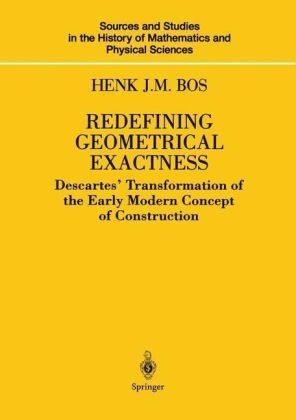Ulteriori informazioni
In his "Géométrie" of 1637 Descartes achieved a monumental innovation of mathematical techniques by introducing what is now called analytic geometry. Yet the key question of the book was foundational rather than technical: When are geometrical objects known with such clarity and distinctness as befits the exact science of geometry? Classically, the answer was sought in procedures of geometrical construction, in particular by ruler and compass, but the introduction of new algebraic techniques made these procedures insufficient. In this detailed study, spanning essentially the period from the first printed edition of Pappus' "Collection" (1588, in Latin translation) and Descartes' death in 1650, Bos explores the current ideas about construction and geometrical exactness, noting that by the time Descartes entered the field the incursion of algebraic techniques, combined with an increasing uncertainty about the proper means of geometrical problem solving, had produced a certain impasse. He then analyses how Descartes transformed geometry by a redefinition of exactness and by a demarcation of geometry's proper subject and procedures in such a way as to incorporate the use of algebraic methods without destroying the true nature of geometry. Although mathematicians later essentially discarded Descartes' methodological convictions, his influence was profound and pervasive. Bos' insistence on the foundational aspects of the "Géométrie" provides new insights both in the genesis of Descartes' masterpiece and in its significance for the development of the conceptions of mathematical exactness.
Sommario
Preface. 1. General introduction. 2. The legitimization of geometrical procedures before 1590. 3. 1588: Pappus' "Collection." 4. The early modern tradition of geometrical problem solving; survey and examples. 5. Early modern methods of analysis. 6. Arithmetic, geometry, algebra and analysis. 7 Using numbers in geometry - Regiomontanus and Stevin. 8. Using algebra - Viète's analysis. 9. Clavius. 10. Viète. 11. Kepler. 12. Molther. 13. Fermat. 14. Geometrical problem solving - the state of the art c. 1635. 15. Introduction to Part II. 16. Construction and the interpretation of exactness in Descartes'studies of c. 1619. 17. Descartes'general construction of solid problems c.1625. 18. Problem solving and construction in the "Rules for the direction of the mind" (c. 1628). 19. Descartes' first studies of Pappus' problem (early 1632). 20. The Geometry, introduction and survey. 21. Algebraic operations in geometry. 22. The use of algebra in solving plane and indeterminate problems. 23. Descartes'solution of Pappus' problem. 24. Curves and the demarcation of geometry in the "Geometry." 25. Simplicity and the classification of curves. 26. The canon of geometrical construction. 27. The theory of Equations in the "Geometry." 28. Conclusion of Part II. 29. Epilogue.
Relazione
"This is a brilliant book and the most satisfactory account of Descartes' mathematical career that I have come across. Although the author does not claim to provide an exhaustive study of Descartes' geometry, he illuminates it in an original way by focusing on the conception and practice of construction. The book covers essentially the period from 1588, when Commandino's Latin translation of the surviving books of Pappus' Collections appeared, to 1650 when Descartes met his untimely death in Sweden. Bos discusses the opinions of five mathematicians who stated their position on construction explicitly, namely Clavius, Vi te, Kepler, Molther and Fermat. He then sketches out the background to Descartes' program for restructuring the art of geometrical problem solving that led to the Geometry of 1637, a work that he analyses in detail. The concluding two chapters summarise the dynamics of Descartes' geometrical thinking and sketch the development that followed upon Descartes' achievement."--MATHEMATICAL REVIEWS

